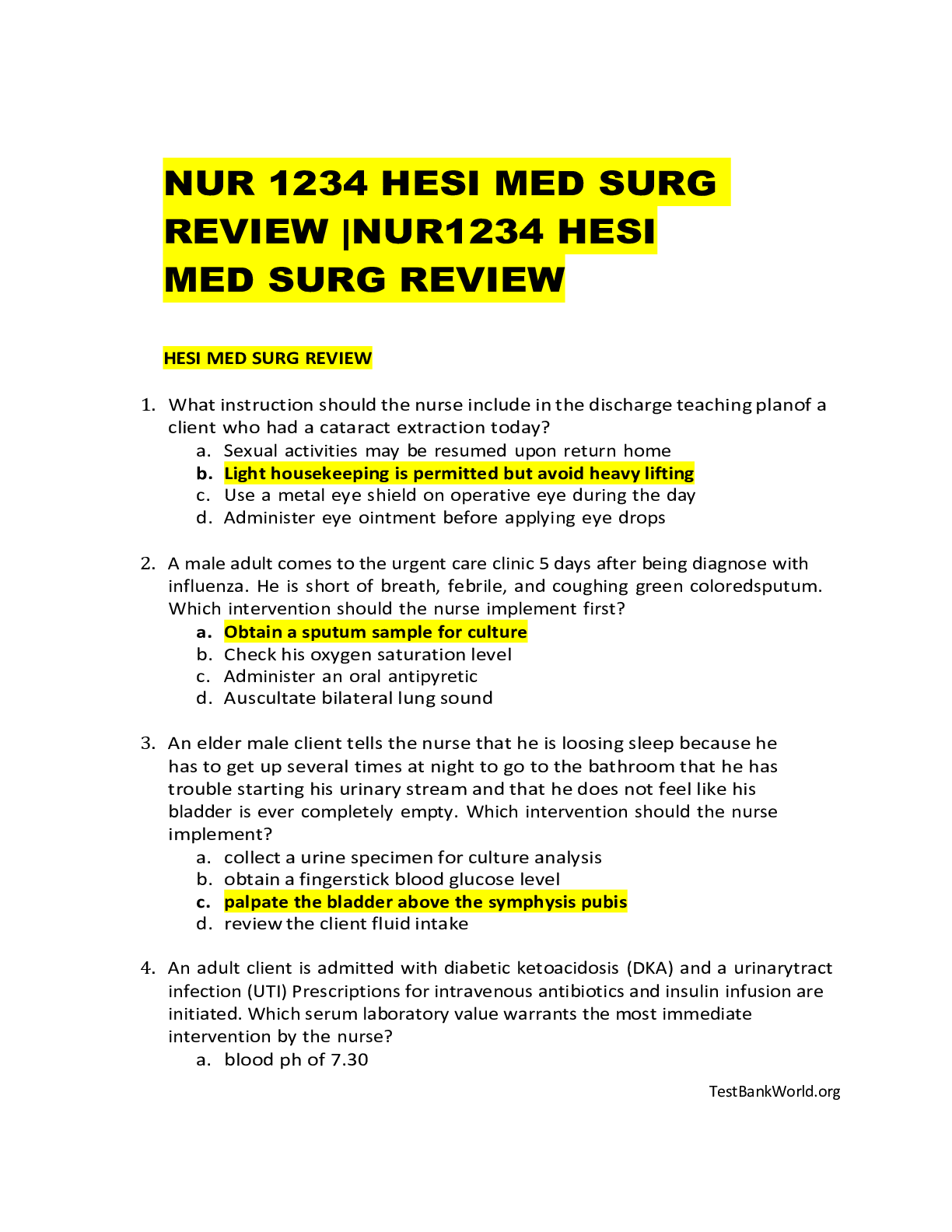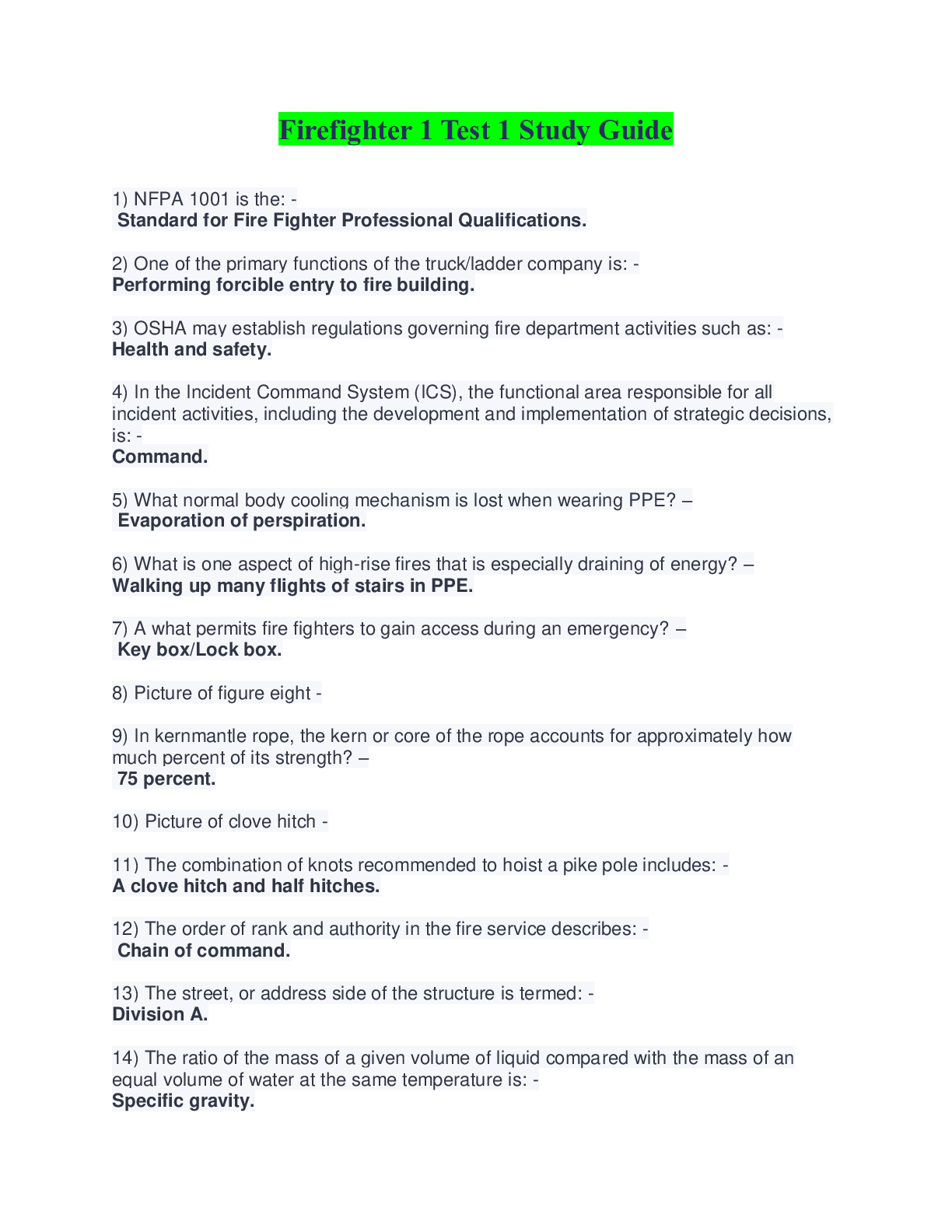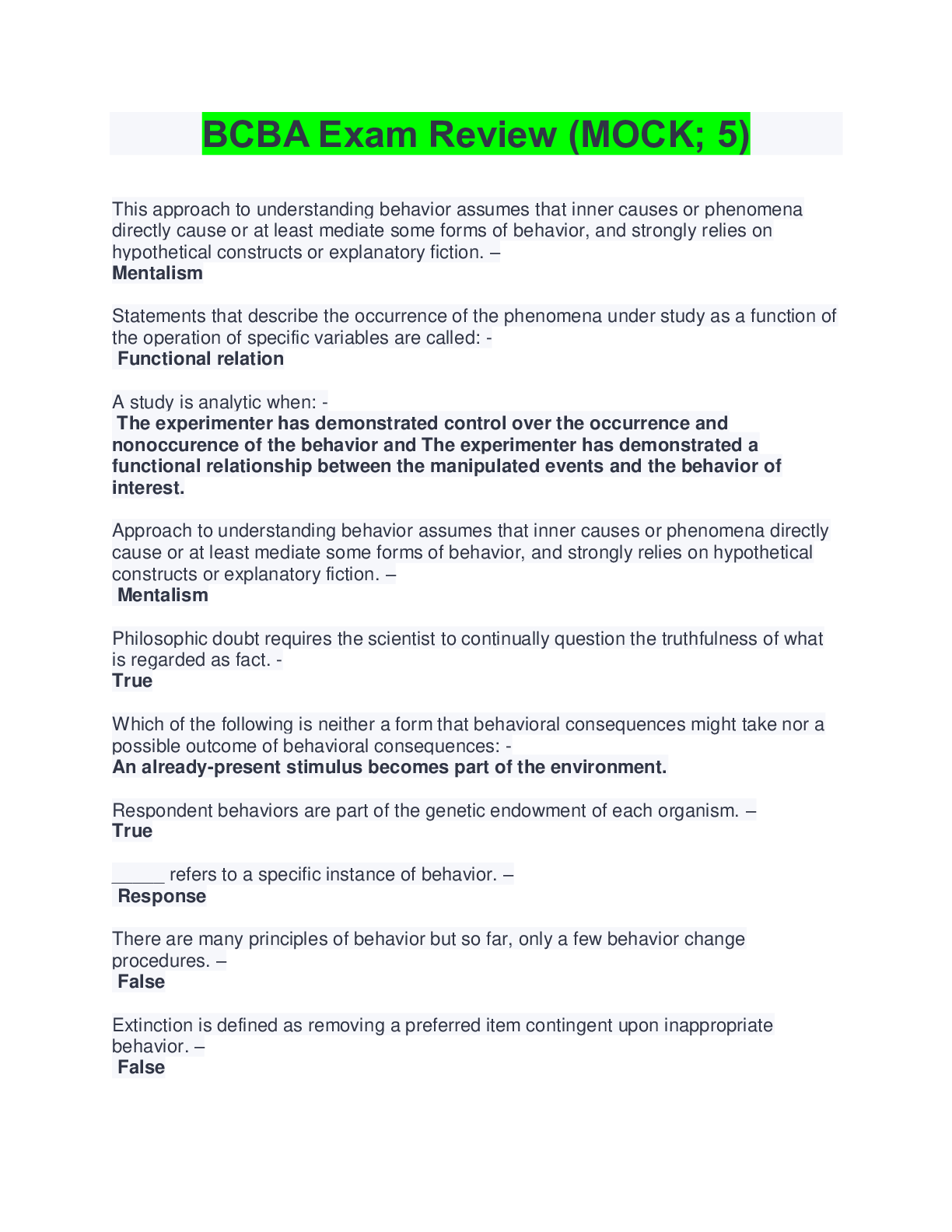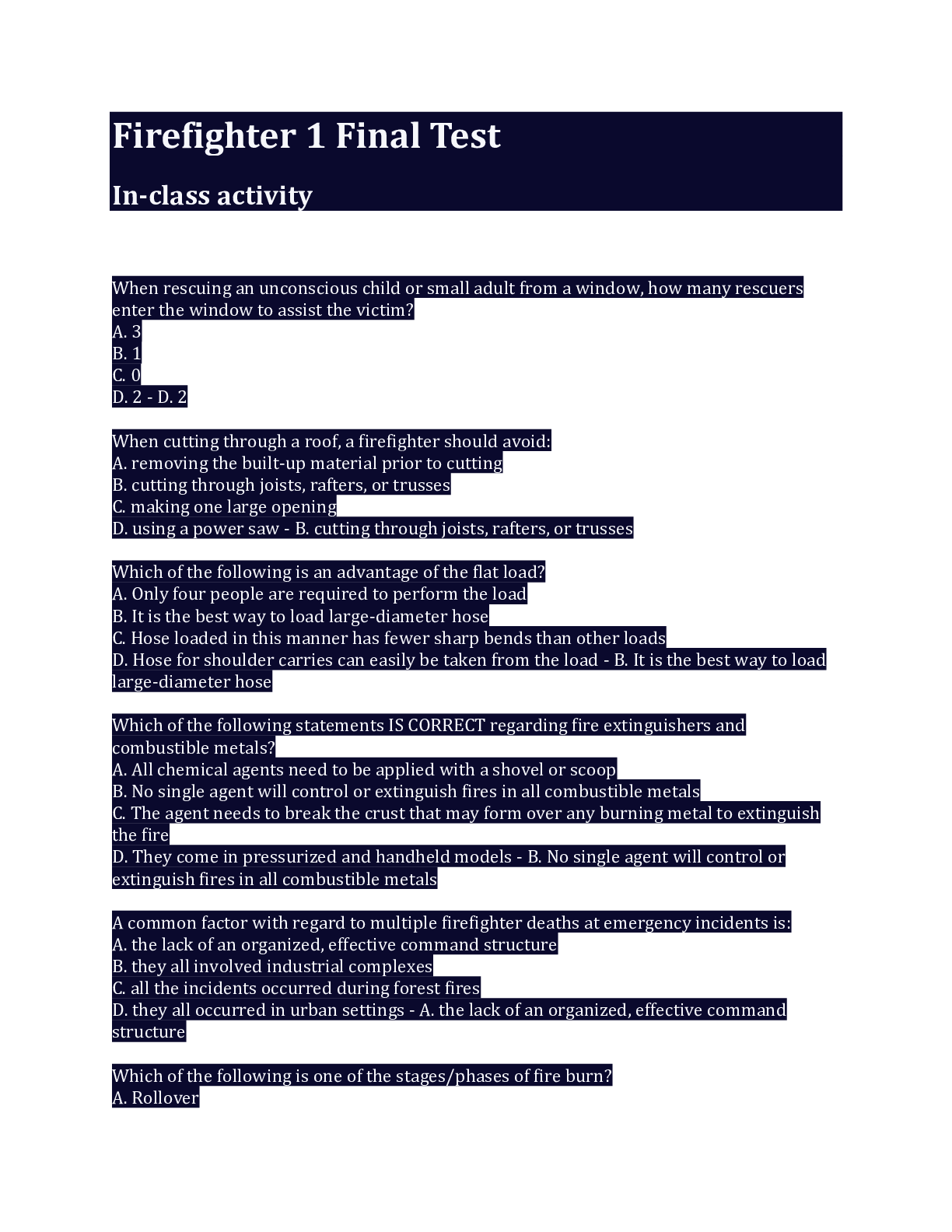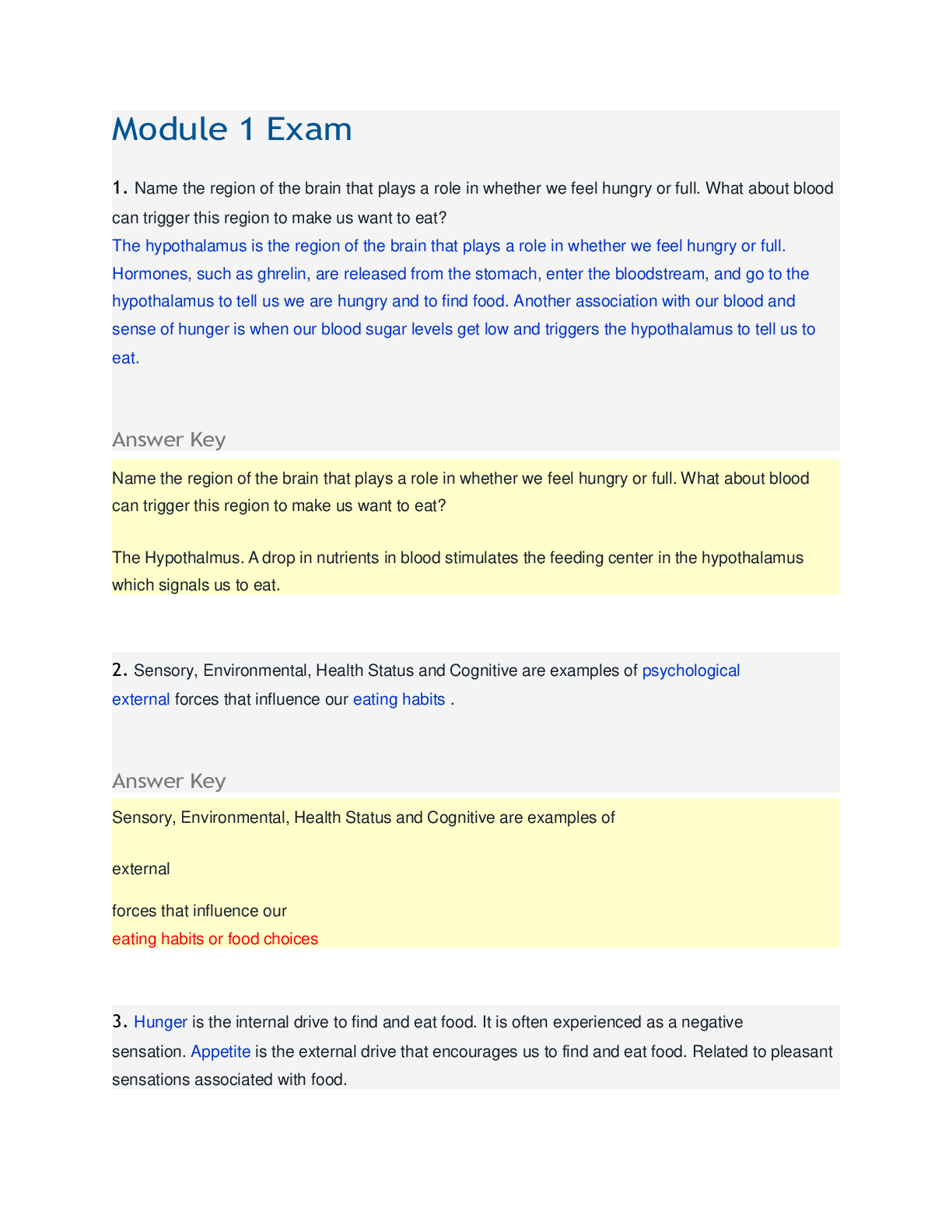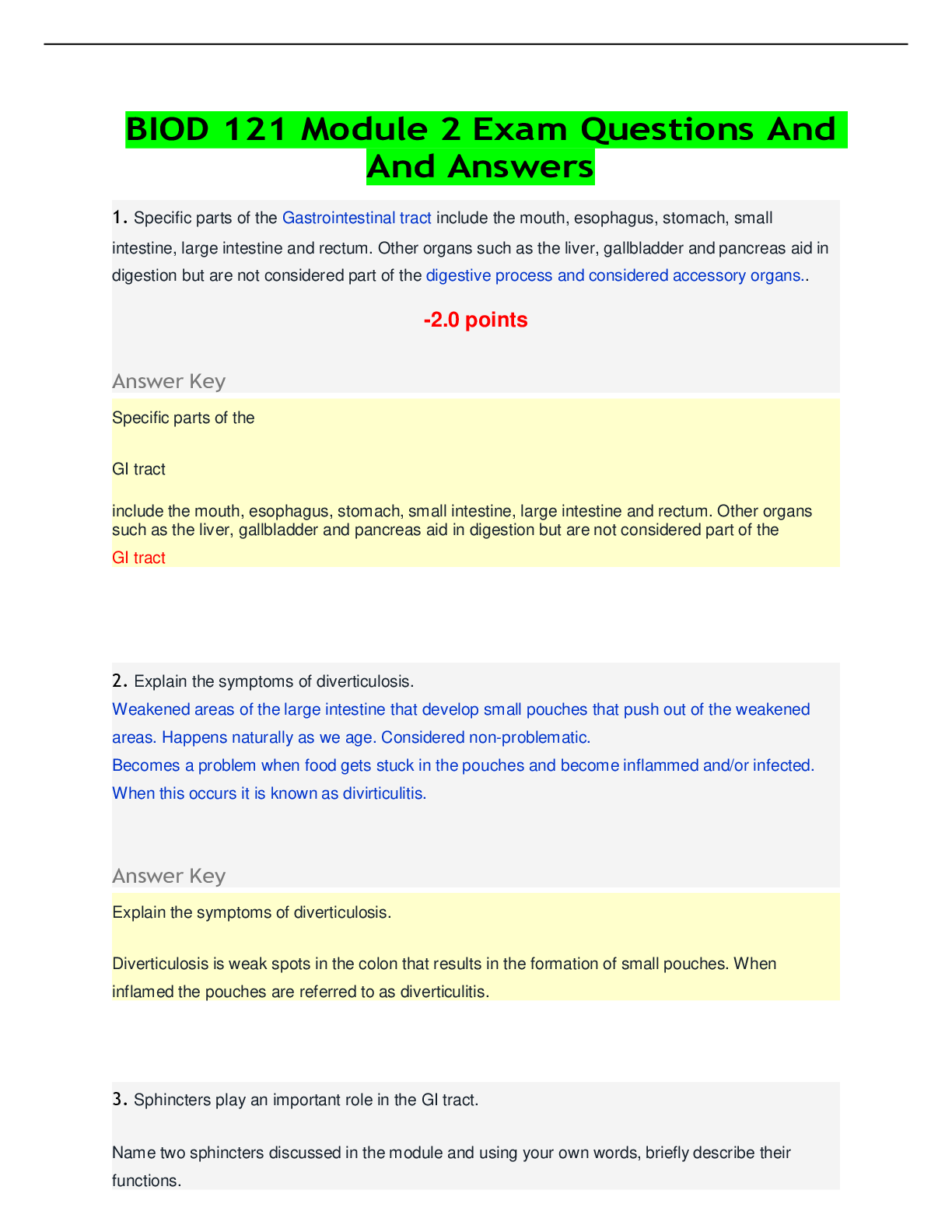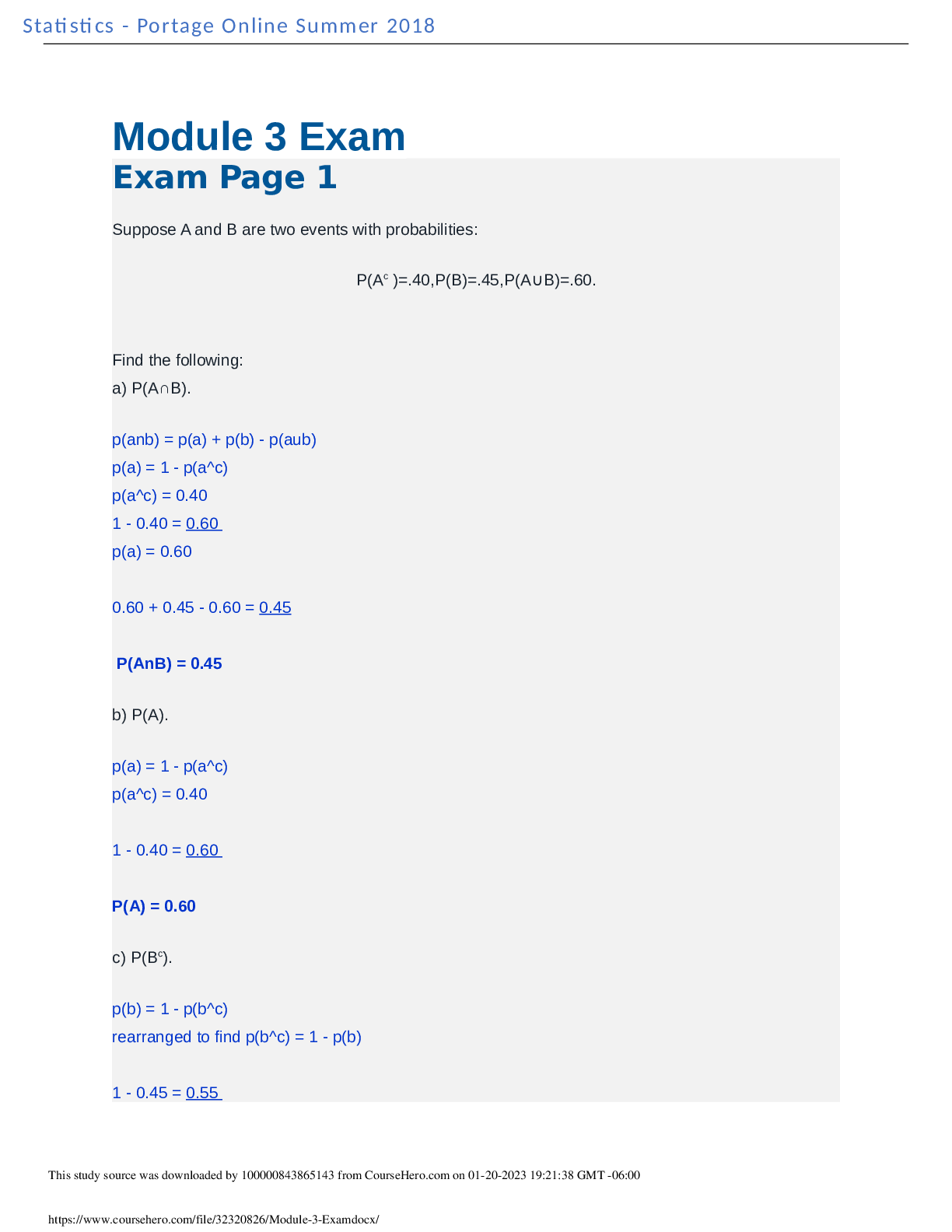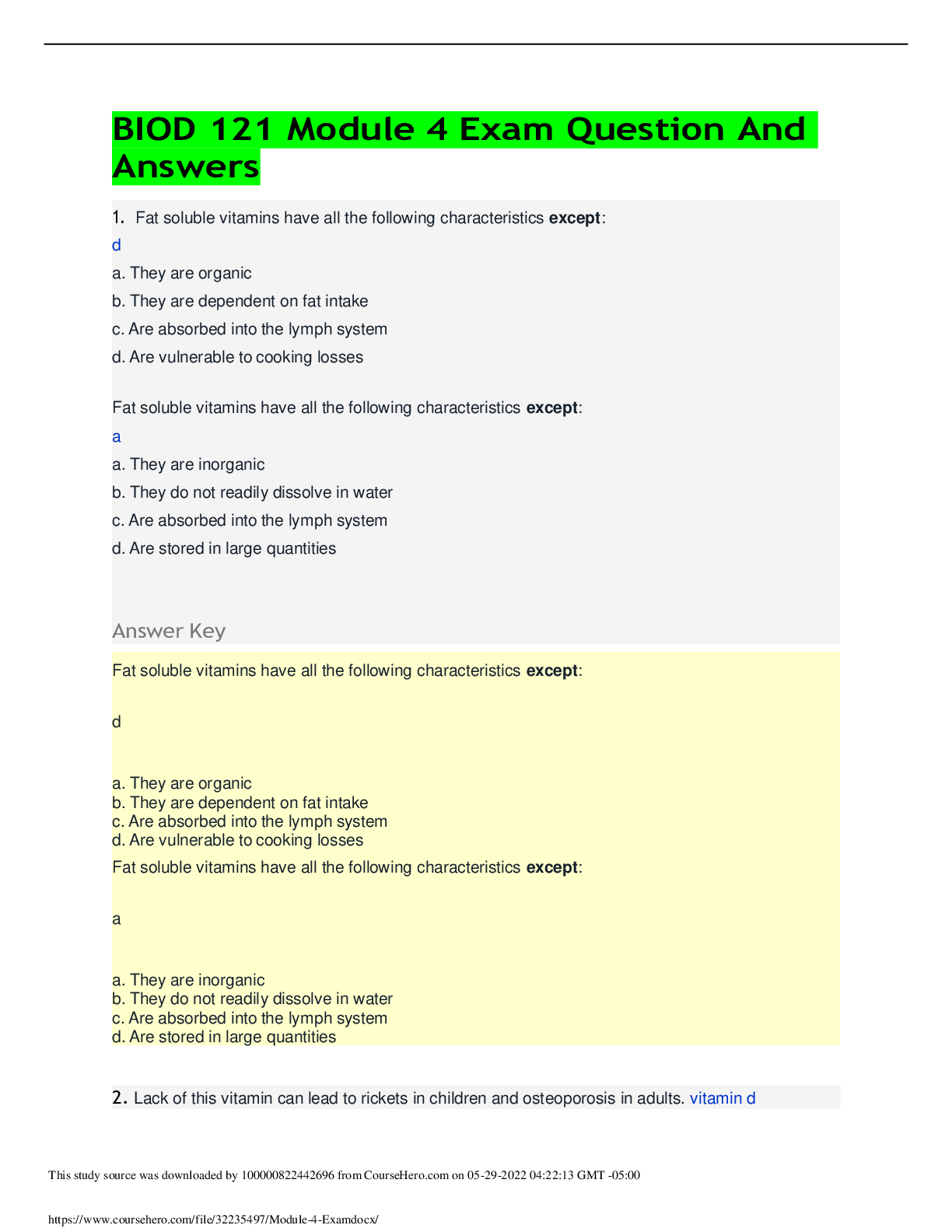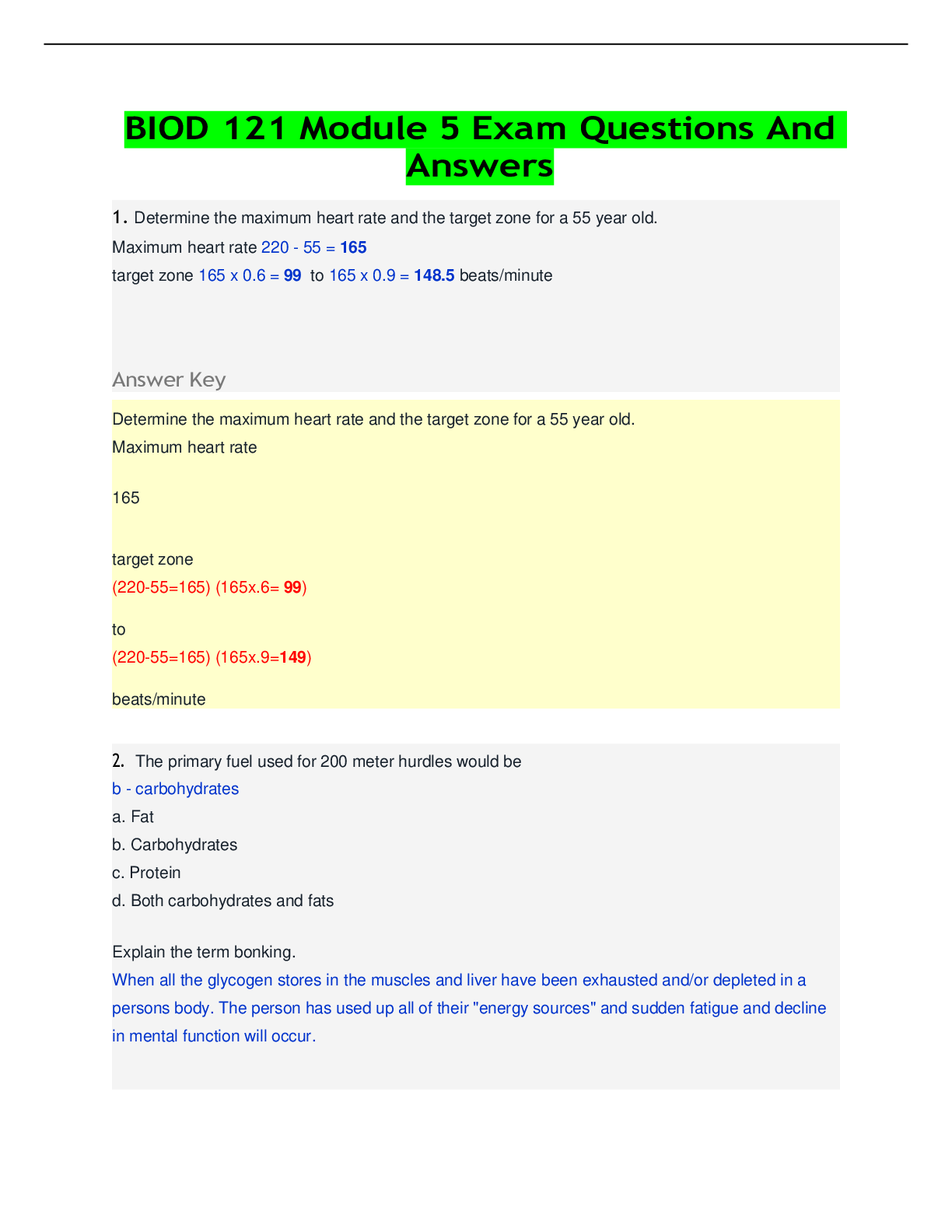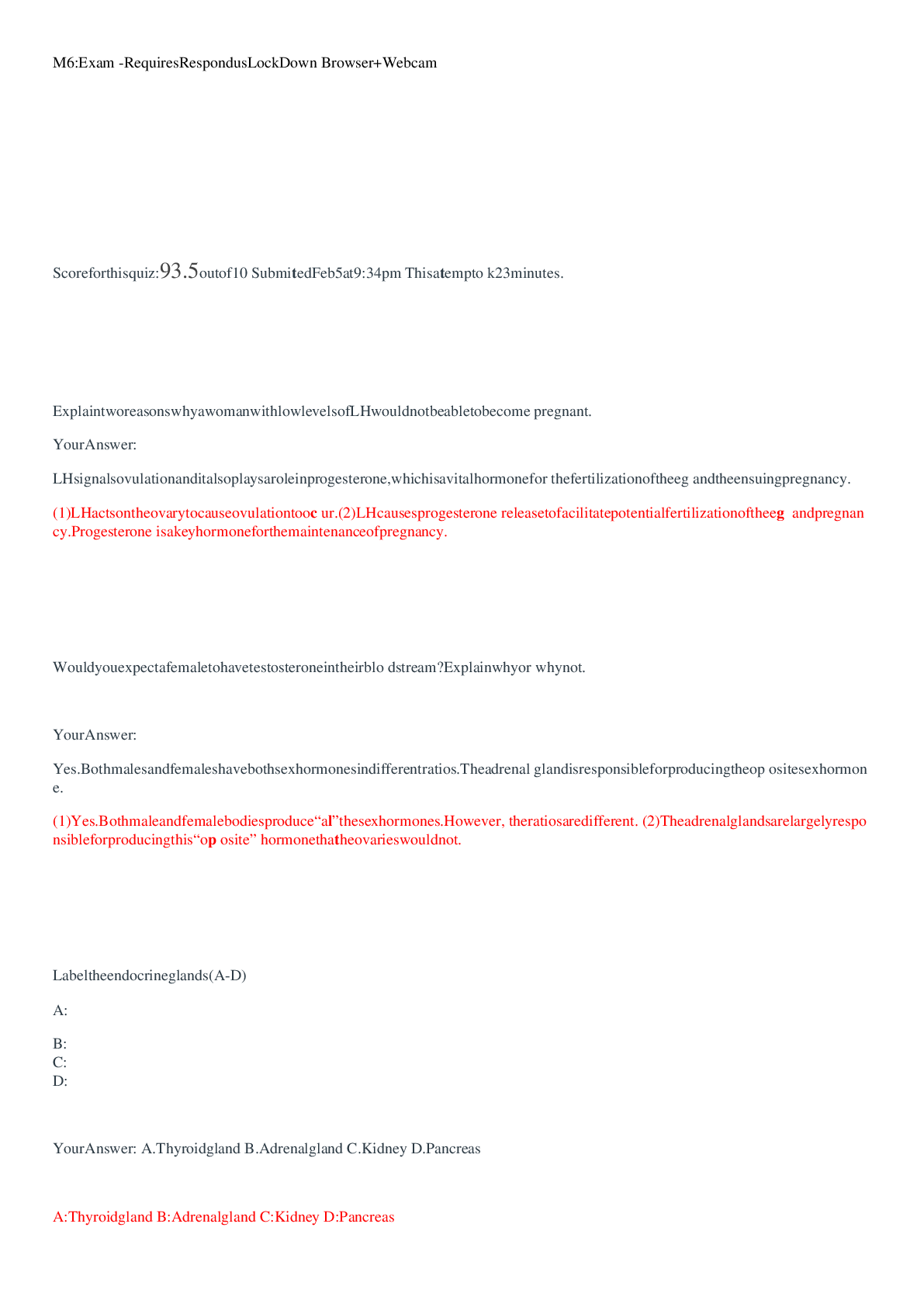NUR 1119skin integrity .docx/; complete solution/RATED A
Document Content and Description Below
NUR 1119skin integrity .docx Question 1 See full question 56s A nursing student is providing a complete bed bath to a 60-year-old diabetic client. The student is conducting an assessment during... the bath. The student observes a red, raised rash under the client's breasts. This manifestation is most consistent with: Question 2 See full question 26s Report this Question The nurse considers the impact of shearing forces in the development of pressure injuries in clients. Which client would be most likely to develop a pressure injury from shearing forces? You Selected: Add a Note Question 3 See full question 23s Report this Question The nurse is teaching a client who is preparing for a left mastectomy due to breast cancer. Which teaching about a Jackson-Pratt drain will the nurse include? Add a Note Question 4 See full question 32s Report this Question The nurse is caring for a client with a knee sprain. Which client statement regarding use of an ice pack indicates that nursing teaching has been effective? Add a Note Question 5 See full question 14s Report this Question Which action by the nurse is most appropriate when attempting to remove surgical staples that have dried blood or drainage on them? Chapter 32: Skin Integrity and Wound Care - Page 1082 Chapter 32: Skin Integrity and Wound Care 3 quizzes taken Your mastery after this quiz 2 Class average 4.32 View current mastery performance for all chapters Answer Key Question 1 See full question 18s Report this Question A pediatric nurse is familiar with specific characteristics of children's skin. Which statement describes the common skin characteristics in a child? You Selected: • An infant's skin and mucous membranes are easily injured and at risk for infection. Correct response: • An infant's skin and mucous membranes are easily injured and at risk for infection. Explanation: An infant's skin and mucous membranes are easily injured and at risk for infection. In children younger than 2 years, the skin is thinner and weaker than in adults. The structure of the skin changes as a person ages. A child's skin becomes more resistant to injury and infection as the child grows. Reference: • Taylor, C., Lynn, P., & Bartlett, J., Fundamentals of Nursing, 9th ed., Philadelphia, Wolters Kluwer, 2019, Chapter 32: Skin Integrity and Wound Care, p. 1045. Chapter 32: Skin Integrity and Wound Care - Page 1045 Add a Note Question 2 See full question 47s Report this Question What type of dressing has the advantage of remaining in place for three to seven days, resulting in less interference with wound healing? You Selected: • hydrocolloid dressing Correct response: • hydrocolloid dressing Explanation: Hydrocolloids are occlusive or semi-occlusive dressings that limit exchange of oxygen between wound and environment, provide minimal to moderate absorption of drainage, maintain a moist wound environment, and may be left in place for three to seven days, thus resulting in less interference with healing. Hydrogels maintain a moist wound environment and are best for partial or full-thickness wounds. Alginates absorb exudate and maintain a moist wound environment. They are best for wounds with heavy exudate. Transparent films allow exchange of oxygen between wound and environment. They are best for small partial-thickness wounds with minimal drainage. Reference: • Taylor, C., Lynn, P., & Bartlett, J., Fundamentals of Nursing, 9th ed., Philadelphia, Wolters Kluwer, 2019, Chapter 32: Skin Integrity and Wound Care, p. 1073. Chapter 32: Skin Integrity and Wound Care - Page 1073 Add a Note Question 3 See full question 46s Report this Question A nurse is cleaning the wound of a client who has been injured by a gunshot. Which guideline is recommended for this procedure? You Selected: • Clean the wound from the top to the bottom and from the center to outside. Correct response: • Clean the wound from the top to the bottom and from the center to outside. Explanation: Using sterile technique, clean the wound from the top to the bottom and from the center to the outside. Dry the area with a gauze sponge, not an absorbent cloth. Reference: • Taylor, C., Lynn, P., & Bartlett, J., Fundamentals of Nursing, 9th ed., Philadelphia, Wolters Kluwer, 2019, Chapter 32: Skin Integrity and Wound Care, pp. 1096-1100. Chapter 32: Skin Integrity and Wound Care - Page 1096-1100 Add a Note Question 4 See full question 55s Report this Question The nurse is assessing the wounds of clients in a burn unit. Which wound would most likely heal by primary intention? You Selected: • a surgical incision with sutured approximated edges Correct response: • a surgical incision with sutured approximated edges Explanation: Wounds healed by primary intention are well approximated (skin edges tightly together). Intentional wounds with minimal tissue loss, such as those made by a surgical incision with sutured approximated edges, usually heal by primary intention. Wounds healed by secondary intention have edges that are not well approximated. Large, open wounds, such as from burns or major trauma, which require more tissue replacement and are often contaminated, commonly heal by secondary intention. If a wound that is healing by primary intention becomes infected, it will heal by secondary intention. Wounds that heal by secondary intention take longer to heal and form more scar tissue. Connective tissue healing and repair follow the same phases in healing. However, differences occur in the length of time required for each phase and in the extent of new tissue formed. Wounds healed by tertiary intention, or delayed primary closure, are those wounds left open for several days to allow edema or infection to resolve or fluid to drain, and then are closed. Reference: • Taylor, C., Lynn, P., & Bartlett, J., Fundamentals of Nursing, 9th ed., Philadelphia, Wolters Kluwer, 2019, Chapter 32: Skin Integrity and Wound Care, p. 1048. Chapter 32: Skin Integrity and Wound Care - Page 1048 Add a Note Question 5 See full question 34s Report this Question Adequate blood flow to the skin is necessary for healthy, viable tissue. Adequate skin perfusion requires four factors. Which is not one of these factors? You Selected: • Local capillary pressure must be lower than external pressure. Correct response: • Local capillary pressure must be lower than external pressure. Explanation: Local capillary pressure must be higher than external pressure for adequate skin perfusion. Reference: • Taylor, C., Lynn, P., & Bartlett, J., Fundamentals of Nursing, 9th ed., Philadelphia, Wolters Kluwer, 2019, Chapter 32: Skin Integrity and Wound Care, p. 1049. Chapter 32: Skin Integrity and Wound Care - Page 1049 Chapter 32: Skin Integrity and Wound Care 4 quizzes taken Your mastery after this quiz 2 Class average 4.32 View current mastery performance for all chapters Answer Key Question 1 See full question 19s Report this Question The nurse would recognize which client as being particularly susceptible to impaired wound healing? You Selected: • a man with a sedentary lifestyle and a long history of cigarette smoking Correct response: • an obese woman with a history of type 1 diabetes Explanation: Obese people tend to be more vulnerable to skin irritation and injury. More significant, however, is the role of diabetes in creating both susceptibility to skin breakdown and impairment of the healing process. This is a greater risk factor for impaired healing than are smoking and sedentary lifestyle. Large incisions in and of themselves do not necessarily complicate the healing process. Short-term lack of food intake is not as significant as longer-term lack of nutrition. Reference: • Taylor, C., Lynn, P., & Bartlett, J., Fundamentals of Nursing, 9th ed., Philadelphia, Wolters Kluwer, 2019, Chapter 32: Skin Integrity and Wound Care, p. 1048. Chapter 32: Skin Integrity and Wound Care - Page 1048 Add a Note Question 2 See full question 25s Report this Question A nurse is caring for a client with dehydration at the health care facility. The client is receiving glucose intravenously. What type of dressing should the nurse use to cover the IV insertion site? You Selected: • transparent Correct response: • transparent Explanation: The nurse should use a transparent dressing to cover the IV insertion site, because such dressings allow the nurse to assess a wound without removing the dressing. In addition, they are less bulky than gauze dressings and do not require tape, since they consist of a single sheet of adhesive material. Gauze dressing is ideal for covering fresh wounds that are likely to bleed or wounds that exude drainage. A hydrocolloid dressing helps keep the wound moist. A bandage is a strip or roll of cloth wrapped around a body part to help support the area around the wound. Reference: • Taylor, C., Lynn, P., & Bartlett, J., Fundamentals of Nursing, 9th ed., Philadelphia, Wolters Kluwer, 2019, Chapter 32: Skin Integrity and Wound Care, p. 1072. Chapter 32: Skin Integrity and Wound Care - Page 1072 Add a Note Question 3 See full question 56s Report this Question A nurse is caring for a client who has a pressure injury on the left great toe. The client is scheduled for debridement the next morning. Based on the red- yellow-black (RYB) Wound Classification System, which classification should the nurse document? You Selected: • Black classification Correct response: • Black classification Explanation: A wound that requires debridement would be classified in the black category. The red classification would indicate dressing changes for treatment. The yellow classification would indicate cleansing of the wound related to the drainage or slough in the wound. Unstageable is not a classification in the RYB Wound Classification System. Reference: • Taylor, C., Lynn, P., & Bartlett, J., Fundamentals of Nursing, 9th ed., Philadelphia, Wolters Kluwer, 2019, Chapter 32: Skin Integrity and Wound Care, p. 1063. Chapter 32: Skin Integrity and Wound Care - Page 1063 Add a Note Question 4 See full question 20s Report this Question The nurse is helping a confused client with a large leg wound order dinner. Which food item is most appropriate for the nurse to select to promote wound healing? You Selected: • Fish Correct response: • Fish Explanation: To promote wound healing, the nurse should ensure that the client's diet is high in protein, vitamin A, and vitamin C. The fish is high in protein and is therefore the most appropriate choice to promote wound healing. Pasta salad has a high carbohydrate amount with no protein. Banana has a high amount of vitamin C but no protein. Green beans have some protein but not as much as fish. Reference: • Taylor, C., Lynn, P., & Bartlett, J., Fundamentals of Nursing, 9th ed., Philadelphia, Wolters Kluwer, 2019, Chapter 32: Skin Integrity and Wound Care, p. 1065. Chapter 32: Skin Integrity and Wound Care - Page 1065 Add a Note Question 5 See full question 16s Report this Question When assessing a wound that a client sustained as a result of surgery, the nurse notes well-approximated edges and no signs of infection. How will the nurse document this assessment finding? You Selected: • incision Correct response: • incision Explanation: An incision is a clean separation of skin and tissue with smooth, even edges. Therefore the nurse documents the finding as an incision. In an avulsion, large areas of skin and underlying tissue have been stripped away. An abrasion involves the stripping of the surface layers of skin. A laceration is a separation of skin and tissue with torn, irregular edges. Therefore the nurse does not document the finding as an avulsion, abrasion, or laceration. Reference: • Taylor, C., Lynn, P., & Bartlett, J., Fundamentals of Nursing, 9th ed., Philadelphia, Wolters Kluwer, 2019, Chapter 32: Skin Integrity and Wound Care, p. 1048. Chapter 32: Skin Integrity and Wound Care - Page 1048 Chapter 32: Skin Integrity and Wound Care 5 quizzes taken Your mastery after this quiz 2 Class average 4.32 View current mastery performance for all chapters Answer Key Question 1 See full question 21s Report this Question The acute care nurse is caring for a client whose large surgical wound is healing by secondary intention. The client asks, "Why is my wound still open? Will it ever heal?" Which response by the nurse is most appropriate? You Selected: • "Your wound will heal slowly as granulation tissue forms and fills the wound." Correct response: • "Your wound will heal slowly as granulation tissue forms and fills the wound." Explanation: This statement is correct, because it provides education to the client: "Your wound will heal slowly as granulation tissue forms and fills the wound." Large wounds with extensive tissue loss may not be able to be closed by primary intention, which is surgical intervention. Secondary intention, in which the wound is left open and closes naturally, is not done if less of a scar is necessary. Third intention is when a wound is left open for a few days and then, if there is no indication of infection, closed by a surgeon. Reference: • Taylor, C., Lynn, P., & Bartlett, J., Fundamentals of Nursing, 9th ed., Philadelphia, Wolters Kluwer, 2019, Chapter 32: Skin Integrity and Wound Care, p. 1084. Chapter 32: Skin Integrity and Wound Care - Page 1084 Add a Note Question 2 See full question 13s Report this Question A Penrose drain typically exits a client's skin through a stab wound created by the surgeon. You Selected: • False Correct response: • True Explanation: A Penrose drain is an open drainage system that exits the skin through a stab wound. The purpose a Penrose drain is to provide a sinus tract for drainage. Reference: • Taylor, C., Lynn, P., & Bartlett, J., Fundamentals of Nursing, 9th ed., Philadelphia, Wolters Kluwer, 2019, Chapter 32: Skin Integrity and Wound Care, p. 1079. Chapter 32: Skin Integrity and Wound Care - Page 1079 Add a Note Question 3 See full question 17s Report this Question A nurse removing sutures from a client's traumatic wound notices that the sutures are encrusted with blood and difficult to remove. What would be the nurse's most appropriate action? You Selected: • Moisten sterile gauze with sterile saline to gently loosen crusts before removing sutures. Correct response: • Moisten sterile gauze with sterile saline to gently loosen crusts before removing sutures. Explanation: If sutures are crusted with dried blood or secretions, making them difficult to remove, the nurse should moisten sterile gauze with sterile saline and gently loosen crusts before removing the sutures; soap is not used for this purpose. Picking at the sutures could cause pain and bleeding. Crusting does not necessarily indicate inadequate wound healing. Reference: • Taylor, C., Lynn, P., & Bartlett, J., Fundamentals of Nursing, 9th ed., Philadelphia, Wolters Kluwer, 2019, Chapter 32: Skin Integrity and Wound Care, p. 1082. Chapter 32: Skin Integrity and Wound Care - Page 1082 Add a Note Question 4 See full question 21s Report this Question The nurse is caring for a client who has recently noted abnormal pigmentation in his skin. What is most likely deficient in the client's diet? You Selected: • Vitamin B12 Correct response: • Zinc Explanation: Adequate intake of iron, copper, and zinc is important to prevent abnormal pigmentation and changes in nails and hair. Reference: • Taylor, C., Lynn, P., & Bartlett, J., Fundamentals of Nursing, 9th ed., Philadelphia, Wolters Kluwer, 2019, Chapter 32: Skin Integrity and Wound Care, p. 1049. Chapter 32: Skin Integrity and Wound Care - Page 1049 Add a Note Question 5 See full question 48s Report this Question The nurse is performing frequent skin assessment at the site where cold therapy has been in place. The nurse notes pallor at the site and the client reports “it feels numb.” What is the best action by the nurse at this time? You Selected: • Notify the health care provider of the findings. Correct response: • Discontinue the therapy and assess the client. Explanation: The best action by the nurse at this time is to discontinue the therapy and assess the client; this should be done before notifying the health care provider or documenting the event. Gently rubbing the area or massaging it would not be appropriate at this time. Reference: • Taylor, C., Lynn, P., & Bartlett, J., Fundamentals of Nursing, 9th ed., Philadelphia, Wolters Kluwer, 2019, Chapter 32: Skin Integrity and Wound Care, p. 1087. Chapter 32: Skin Integrity and Wound Care - Page 1087 Chapter 32: Skin Integrity and Wound Care 6 quizzes taken Your mastery after this quiz 2 Class average 4.32 View current mastery performance for all chapters Answer Key Question 1 See full question 2m 32s Report this Question A medical-surgical nurse is assisting a wound care nurse with the debridement of a client's coccyx wound. What is the primary goal of this action? You Selected: • removing dead or infected tissue to promote wound healing Correct response: • removing dead or infected tissue to promote wound healing Explanation: Debridement is the act of removing debris and devitalized tissue in order to promote healing and reduce the risk of infection. Debridement does not directly stimulate the wound bed, and the goal is neither assessment nor the prevention of maceration. Reference: • Taylor, C., Lynn, P., & Bartlett, J., Fundamentals of Nursing, 9th ed., Philadelphia, Wolters Kluwer, 2019, Chapter 32: Skin Integrity and Wound Care, p. 1054. Chapter 32: Skin Integrity and Wound Care - Page 1054 Add a Note Question 2 See full question 1m 4s Report this Question A postoperative client is being transferred from the bed to a gurney and states, “I feel like something has just given away.” What should the nurse assess in the client? You Selected: • Dehiscence of the wound Correct response: • Dehiscence of the wound Explanation: Dehiscence is the partial or total separation of wound layers as a result of excessive stress on wounds that are not healed. Clients at greater risk for these complications include those who are obese or malnourished, smoke tobacco, use anticoagulants, have infected wounds, or experience excessive coughing, vomiting, or straining. An increase in the flow of fluid from the wound between postoperative days 4 and 5 may be a sign of an impending dehiscence. The client may say that “something has suddenly given way.” If dehiscence occurs, cover the wound area with sterile towels moistened with sterile 0.9% sodium chloride solution and notify the physician. Once dehiscence occurs, the wound is managed like any open wound. Manifestations of infection include redness, warmth, swelling, and heat. With herniation, there is protrusion through a bodily opening. Evisceration is a term that describes protrusion of intra-abdominal contents. Reference: • Taylor, C., Lynn, P., & Bartlett, J., Fundamentals of Nursing, 9th ed., Philadelphia, Wolters Kluwer, 2019, Chapter 32: Skin Integrity and Wound Care, p. 1053. Chapter 32: Skin Integrity and Wound Care - Page 1053 Add a Note Question 3 See full question 17s Report this Question Which is not considered a skin appendage? You Selected: • Hair Correct response: • Connective tissue Explanation: Hair, the sebaceous gland, and eccrine sweat glands are skin appendages that are formed with the enfolding of the epidermis into the dermis. The dermis is composed of connective tissue. Reference: • Taylor, C., Lynn, P., & Bartlett, J., Fundamentals of Nursing, 9th ed., Philadelphia, Wolters Kluwer, 2019, Chapter 32: Skin Integrity and Wound Care, p. 1042. Chapter 32: Skin Integrity and Wound Care - Page 1042 Add a Note Question 4 See full question 53s Report this Question A nurse is evaluating a client who was admitted with partial-thickness or second-degree burns. Which describes this type of burn? You Selected: • Usually moist with blisters, which may be pink, red, pale ivory, or light yellow-brown Correct response: • Usually moist with blisters, which may be pink, red, pale ivory, or light yellow-brown Explanation: Second-degree burns are moderate to deep partial-thickness burns that may be pink, red, pale ivory, or light yellow-brown. They are usually moist with blisters. First-degree burns are superficial and may be pinkish or red with no blistering. Third-degree burns are full-thickness burns and may vary from brown or black to cherry-red or pearly-white; bullae may be present; can appear dry and leathery. Reference: • Taylor, C., Lynn, P., & Bartlett, J., Fundamentals of Nursing, 9th ed., Philadelphia, Wolters Kluwer, 2019, Chapter 32: Skin Integrity and Wound Care, p. 1073. Chapter 32: Skin Integrity and Wound Care - Page 1073 Add a Note Question 5 See full question 24s Report this Question What is the best nursing diagnosis to describe a minor laceration to the finger, sustained when a client was cutting fruit with a knife in the kitchen? You Selected: • Impaired Skin Integrity related to open wound Correct response: • Impaired Skin Integrity related to open wound Explanation: Impaired skin integrity best describes the minor laceration. While the other diagnoses, Pain, Knowledge Deficit, and Risk for Infection, are all possible as a result of the laceration, there is no indication in the scenario that they are the case. Reference: • Taylor, C., Lynn, P., & Bartlett, J., Fundamentals of Nursing, 9th ed., Philadelphia, Wolters Kluwer, 2019, Chapter 32: Skin Integrity and Wound Care, p. 1048. Chapter 32: Skin Integrity and Wound Care - Page 1048 [Show More]
Last updated: 2 years ago
Preview 1 out of 20 pages
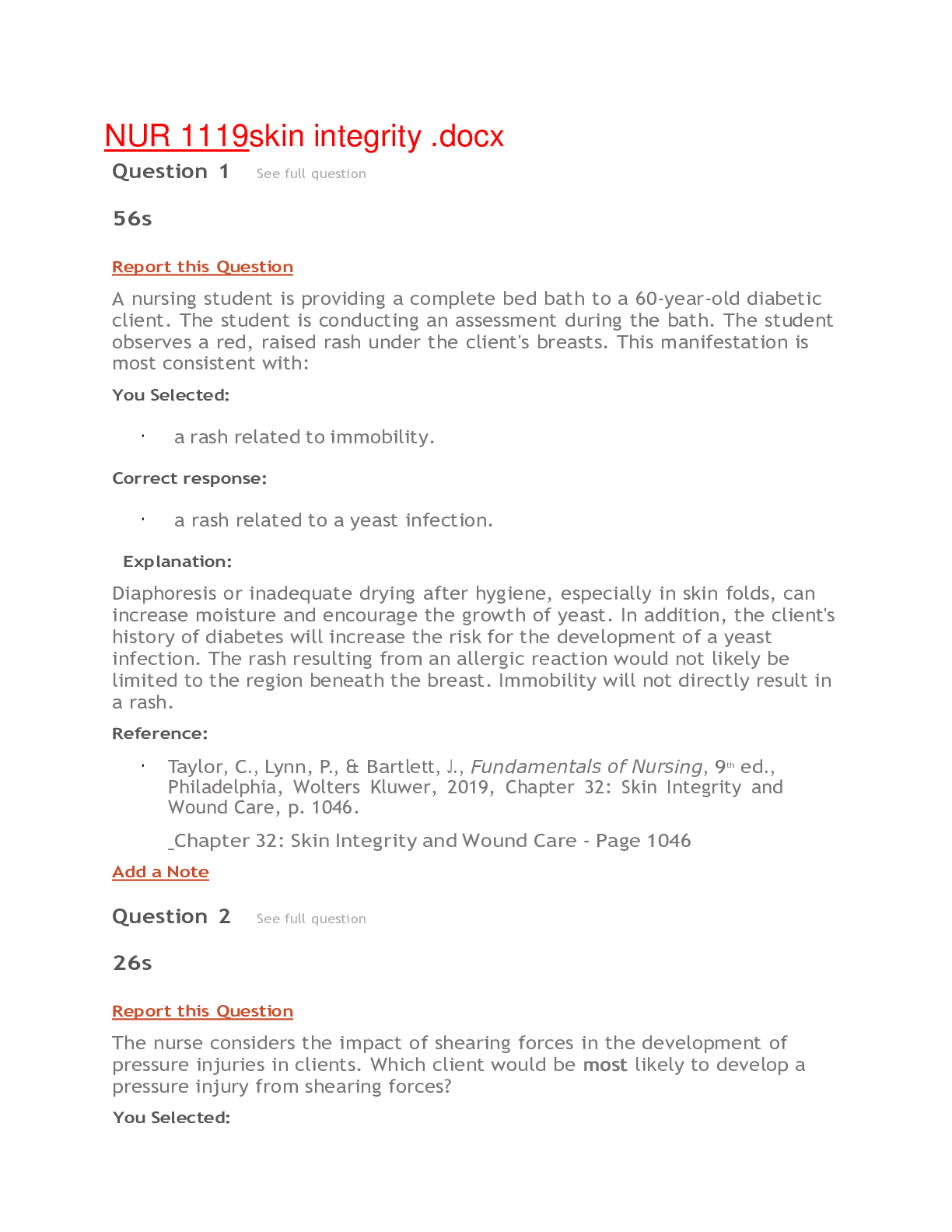
Buy this document to get the full access instantly
Instant Download Access after purchase
Buy NowInstant download
We Accept:

Reviews( 0 )
$11.50
Can't find what you want? Try our AI powered Search
Document information
Connected school, study & course
About the document
Uploaded On
Jul 24, 2021
Number of pages
20
Written in
Additional information
This document has been written for:
Uploaded
Jul 24, 2021
Downloads
0
Views
46


